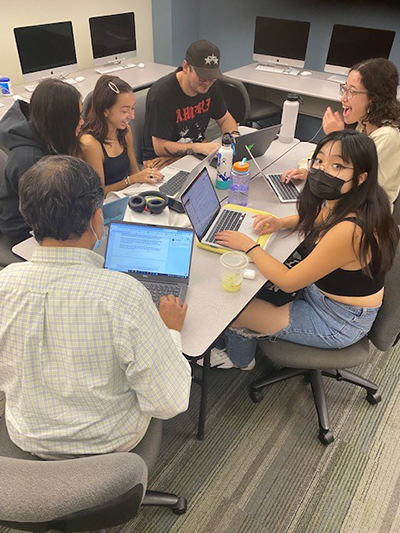By Lauren Milideo
A new curriculum starts students working with local media from day one at Chapman University in southern California.
“The concept is predicated on the teaching hospital model of journalism education. We’re building MASH units on the frontlines of democracy,” said Professor Susan Paterno, Journalism Program Director at California’s Chapman University. Called the Collegiate News Service – the program collaborates with the local nonprofit news organization the Voice of OC, serving Orange County, California – in almost every class, filling local news gaps.
“We rethought our curriculum and made it completely civic-news-oriented, so that nearly all of our courses -- introduction to journalism; reporting on public affairs; advanced reporting; editing; photojournalism, digital media, podcasting -- everything now is geared toward teaching students how to report unbiased, nonpartisan civic news.”
The program’s nearly 70 students move through a curriculum from introductory to more advanced classes in which students are assigned a city in a news deserts in Orange County, Paterno said. More than half of Orange County’s 34 cities and the majority of the school boards lack regular news coverage, most in the less-wealthy and more diverse northern part of the county, Paterno said.
Students work with Voice of OC publisher Norberto Santana, Jr., who is a lecturer at Chapman, and Vik Jolly, assistant professor of practice in Chapman’s English Department and Voice of OC’s Collegiate News Service Editor. The partnership has recently expanded to include the Laguna Beach Independent and the Orange County Tribune.
The students advance from basic civic news coverage to enterprise pieces covering the same cities they had been covering before, Paterno said.
“But now, they're working on identifying enterprise pieces that look beyond just routine coverage. They're looking for patterns. They're looking for ways to go beyond just the surface city coverage. That's public affairs reporting.”
Seniors then move into a two-semester course sequence in which they may cover a more complex topic. One project that came out of this course, Paterno said, was “a project for Voice of OC called Unheard… which held city officials’ feet to the fire and forced them to provide services to the hearing-impaired community, which they were not providing previously, because no one had looked at what services are mandated and what services were being provided.” The story appeared on the Voice of OC website in March 2022.
“For the news organization and more broadly for the well-being of society, these student journalists are the foot soldiers of democracy,” Jolly, the Voice of OC college news editor said. “Voice of OC and readers benefit from the student reports because they add more breadth to the nonprofit news outlets’ coverage. Students are generally covering the least-reported-on cities in Orange County – often news deserts where other media rarely shine any light – thus helping extend the Voice of OC’s reach deeper into the county.”
With 34 cities, 28 public K-12 school districts and 26 law enforcement agencies in Orange County, it is challenging for local media to provide civic coverage across the board.
“Are you ever going to have enough reporters to do that?” Santana said, adding he realized it was not fiscally possible for a small nonprofit like Voice of OC, or another paper, to provide this coverage.
But the student reporters help to fill that gap. “Every published dispatch or a story that the student journalists produce adds a layer of information that’s important for the affected communities, enabling readers to get engaged with news that they otherwise might not receive,” Jolly noted. “In the end, well-informed readers generally participate in community dialog, spurring further civic engagement and action that helps keep our democracy humming.”
The work of running the collaborative project is time-consuming and intense, Paterno noted, and one of her most urgent goals is fundraising, writing grants to hire staff, which is the greatest challenge at the moment.
Santana noted of student journalism, “It does not bring you free content. It does bring you additional content. But,” he added, “they require a lot of editing. They require a lot of leadership. They require a lot of patience. But just like anything – you know, I'm a Little League baseball coach... One season, they come in and they can barely bat. The next season, they’re getting on base. The next season, they're starting to steal bases. And that's what we're seeing.”
Paterno is also working to address the staffing issue by seeking other local academic collaborators. “Part of what we're trying to do here with Voice of OC is start partnerships with community colleges,” she said, noting that she is working with Sarah Bennett of Santa Ana College. In October, Paterno and Chapman faculty will meet with faculty at California State University, Fullerton to discuss expanding the teaching hospital model there. Jeremy Shermak, of Orange Coast College, also plan to search for opportunities to collaborate going forward.
“We have one faculty member who is also the Collegiate News Service editor at Voice of OC, and he has posting privileges,” Paterno said. “So that helps. But if we have anything that goes beyond just routine city council or school board coverage, anything that's the least bit controversial, we need to have another set of eyes look at it. And that's the logjam we face.”
“We're hoping to find grant funding that will fill in the gaps, and put more resources into Voice of OC so they can hire more professional staff, allowing us to expand into the community colleges,” Paterno said.
For more information:


